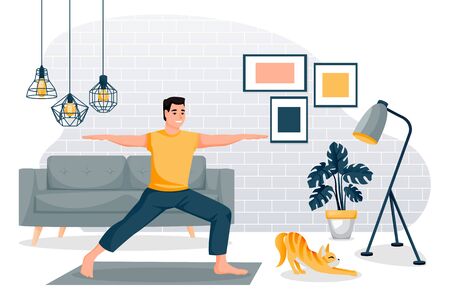1. Understanding Feline Stress and Anxiety
Cats may seem independent and low-maintenance, but they are sensitive creatures that can experience stress and anxiety just like humans. Understanding what triggers these feelings in your feline friend is the first step to helping them feel safe and secure.
Common Causes of Stress and Anxiety in Cats
Several factors can contribute to stress in cats. These range from environmental changes to health issues and even social interactions with other pets or people.
Environmental Changes
Cats are creatures of habit, so any change in their environment can be a source of stress. Some common environmental stressors include:
- Moving to a new home
- Rearranging furniture or introducing new household items
- Loud noises such as fireworks, thunderstorms, or construction
- Changes in routine, such as a new work schedule for their owner
Medical Issues
Pain or discomfort from underlying medical conditions can also cause anxiety in cats. If your cat is suddenly acting stressed, its important to rule out potential health problems. Common medical-related stressors include:
- Urinary tract infections
- Arthritis or joint pain
- Dental issues
- Disease-related discomfort (e.g., kidney disease, hyperthyroidism)
Social Dynamics
Cats have unique social structures, and disruptions in their relationships can lead to stress. Social-related stressors might include:
| Social Stressor | Description |
|---|---|
| New Pet Introduction | A new cat or dog in the home can make your cat feel threatened or insecure. |
| Tension with Other Pets | Cats may struggle with territorial disputes or dominance battles. |
| Lack of Socialization | Cats that aren’t properly socialized may become anxious around strangers. |
| Losing a Companion | The loss of a pet or human companion can lead to grief and depression. |
2. Body Language and Behavioral Changes
Understanding your cat’s body language is key to recognizing signs of stress and anxiety. Cats communicate their emotions through subtle physical cues, including their posture, tail movements, ear positioning, and vocalizations. By paying close attention to these signals, you can better understand how your feline friend is feeling.
Body Posture
A cats overall posture can reveal a lot about their emotional state. A relaxed cat will have a loose body with slightly bent legs, while a stressed or anxious cat may exhibit a tense stance.
| Posture | Meaning |
|---|---|
| Crouching low with tense muscles | Fear or anxiety |
| Arched back with fur standing up | Feeling threatened or defensive |
| Rolling onto back but tense | Defensive rather than playful |
| Relaxed lying on side | Comfortable and content |
Tail Movements
Your cat’s tail is like a mood barometer. Different movements and positions can indicate different emotions.
| Tail Position | Meaning |
|---|---|
| Puffed-up tail | Fear or aggression |
| Tucked between legs | Anxiety or submission |
| Slow swishing back and forth | Irritation or mild annoyance |
| Fast whipping motion | High agitation or anger |
| Upright with a slight curve at the top | Friendly and confident |
| Twitching at the tip only | Mild curiosity or irritation |
Ear Positioning
A cat’s ears are highly expressive and can quickly shift based on their mood.
- Ears forward: Interested, curious, or happy.
- Ears flattened against head: Fearful, anxious, or defensive.
- Ears swiveling rapidly: On high alert, possibly overstimulated.
- Ears slightly tilted back: Mild irritation or uncertainty.
- Ears pinned back tightly: Angry or ready to defend themselves.
Vocalizations and Sounds
Cats use different vocalizations to express their emotions. Some sounds are normal, while others may indicate stress.
| Sound Type | Possible Meaning |
|---|---|
| Purring (with tense body) | Nervous self-soothing rather than contentment. |
| Hissing or growling | Fear, aggression, or extreme discomfort. |
| Excessive meowing/yowling | Anxiety, stress, or seeking attention. |
| Chirping or trilling | A friendly greeting or excitement. |
| Screaming or loud yowls | Pain, fear, or distress. |
| No vocalization but wide eyes and tense body | Panic or silent fear response. |
Recognizing the Signs Early On
If you notice any of these body language changes in your cat, it’s important to assess their environment for potential stressors. Common triggers include loud noises, new pets in the home, changes in routine, or unfamiliar visitors. By identifying these signs early on, you can take steps to make your cat feel more comfortable and secure.

3. Common Stress Triggers in Cats
Cats are sensitive creatures, and even small changes in their environment can cause stress and anxiety. Understanding what triggers stress in your cat can help you create a more comfortable and secure home for them.
Household Changes
Major shifts in the household can be unsettling for cats. Whether it’s moving to a new home, rearranging furniture, or introducing new family members, these changes can disrupt their sense of security.
| Household Change | Possible Cat Reaction |
|---|---|
| Moving to a new home | Hiding, loss of appetite, excessive grooming |
| New baby or roommate | Avoidance, increased vocalization, aggression |
| Rearranging furniture | Nervousness, pacing, hesitation to explore |
Interactions with Other Pets
Cats are territorial animals, and introducing a new pet or dealing with conflicts among existing pets can be stressful. Even if they’ve lived together for a long time, sudden changes in behavior from other pets can trigger anxiety.
- New pet introduction: Can lead to defensive behaviors like hissing and swatting.
- Tension between existing pets: May result in one cat avoiding common areas or showing aggression.
- Lack of personal space: If a cat doesn’t have its own safe area, it may become withdrawn or irritable.
Loud Noises and Sudden Sounds
Noisy environments can be overwhelming for cats. Thunderstorms, fireworks, vacuum cleaners, and even loud music may cause them to hide or show signs of stress.
How Loud Noises Affect Cats
| Noisy Situation | Common Cat Response |
|---|---|
| Fireworks or thunderstorms | Panic, hiding under furniture, trembling |
| Loud appliances (vacuum, blender) | Darting away, flattened ears, dilated pupils |
| Loud conversations or parties | Avoiding people, staying in secluded areas |
Lack of Stimulation
Cats need mental and physical stimulation to stay happy. Without enough playtime or enrichment activities, they may develop anxiety-related behaviors such as excessive grooming or destructive scratching.
Ways to Keep Your Cat Engaged
- Toys and puzzles: Interactive toys keep their minds active.
- Shelving and climbing areas: Cats love vertical spaces for observation and relaxation.
- Sensory stimulation: Cat-safe plants like catnip or different textures to explore can help reduce boredom.
- Daily playtime: Regular interaction strengthens your bond and prevents restlessness.
If you notice signs of stress in your cat, identifying the trigger is the first step toward helping them feel secure again. By making small adjustments to their environment and routine, you can provide a calm and comforting space where they feel safe.
4. Helping Your Cat Cope with Stress
Just like humans, cats need a sense of security and stability to feel comfortable in their environment. If your cat is showing signs of stress or anxiety, there are practical steps you can take to help them feel more at ease.
Creating Safe Spaces
Cats love having a quiet, secure place where they can retreat when they feel overwhelmed. Providing designated safe spaces can make a big difference in reducing their stress levels.
How to Set Up a Safe Space
- Choose a Quiet Area: Find a low-traffic space where your cat can relax undisturbed.
- Add Comfortable Bedding: A soft blanket or cat bed will make the area cozy and inviting.
- Provide Hiding Spots: Use enclosed beds, covered boxes, or even a small tent to create a sense of security.
- Include Familiar Scents: Placing an item that smells like you, such as a worn T-shirt, can be comforting for your cat.
Using Calming Products
If your cat continues to show signs of anxiety, calming products may help. These products work by mimicking natural feline pheromones or providing soothing effects.
Popular Calming Products for Cats
| Product Type | Description |
|---|---|
| Pheromone Diffusers | Mimic natural cat pheromones to promote relaxation. |
| Calming Treats | Treats infused with ingredients like L-theanine and chamomile to reduce stress. |
| Anxiety Wraps | A snug-fitting wrap that provides gentle pressure to calm nervous cats. |
| Herbal Sprays | Naturally derived sprays that create a soothing environment. |
Establishing a Consistent Routine
Cats thrive on routine, and sudden changes can cause stress. Maintaining consistency in their daily schedule helps them feel secure.
Tips for a Stable Routine
- Feed at Regular Times: Serve meals at the same time each day to create predictability.
- Create Playtime Rituals: Engage in interactive play sessions at set times to give your cat an outlet for energy.
- Avoid Sudden Changes: Introduce new people, pets, or furniture gradually to prevent overwhelming your cat.
- Keeps Litter Box Location Consistent: Moving the litter box frequently can cause unnecessary anxiety.
By implementing these strategies, you can help your cat manage stress and create a peaceful environment where they feel safe and happy.
5. When to Seek Professional Help
While some signs of stress and anxiety in cats can be managed with small changes at home, there are times when professional intervention is necessary. If your cat’s behavior becomes extreme or persistent, seeking help from a veterinarian or a certified animal behaviorist may be the best course of action.
Signs That Require Veterinary Attention
If you notice any of the following symptoms, it may be time to consult a veterinarian:
| Sign | Possible Concern |
|---|---|
| Excessive grooming leading to bald spots | Stress-induced overgrooming or skin conditions |
| Aggression towards humans or other pets | Anxiety, fear, or underlying medical issues |
| Litter box avoidance | Urinary tract infection, stress, or territorial issues |
| Persistent hiding and withdrawal | Anxiety, depression, or illness |
| Lack of appetite for more than 24 hours | Pain, illness, or severe stress |
| Excessive vocalization (crying, yowling) | Anxiety, cognitive dysfunction, or discomfort |
The Role of Behavioral Therapy
If medical conditions are ruled out but your cat continues to show signs of stress or anxiety, behavioral therapy might help. A certified feline behaviorist can assess the situation and provide solutions such as:
- Environmental modifications: Adjusting your home setup to reduce stress triggers.
- Pheromone therapy: Using synthetic pheromones like Feliway to create a calming environment.
- Routine adjustments: Establishing consistent feeding and play schedules.
- Cognitive stimulation: Providing enrichment activities such as puzzle feeders and interactive toys.
- Desensitization training: Gradually exposing your cat to stressful situations in a controlled manner.
The Use of Medication for Anxiety
If behavioral interventions alone are not enough, medication might be considered. Your veterinarian may recommend options such as:
- Anxiolytics: Medications like fluoxetine or clomipramine to help manage chronic anxiety.
- Sedatives: Short-term medications like gabapentin for specific stressful events (e.g., vet visits).
- Nutritional supplements: Products containing L-theanine or tryptophan that promote relaxation.
- Pheromone diffusers: Non-medicated options that mimic natural calming signals.
When Immediate Action Is Needed
If your cat displays sudden drastic changes in behavior, such as unprovoked aggression, self-harm (excessive biting/scratching), or complete refusal to eat/drink for over 48 hours, seek veterinary attention immediately. These could be signs of serious health conditions requiring urgent care.
The Bottom Line: Trust Your Instincts
You know your cat best. If something feels off, don’t hesitate to reach out to a professional. Early intervention can prevent stress-related issues from escalating into long-term problems.


